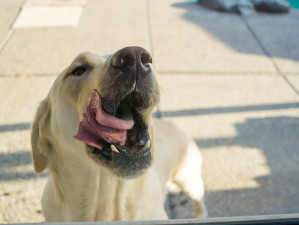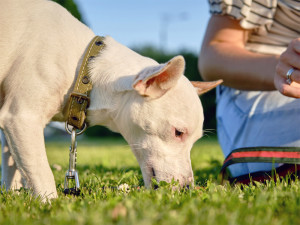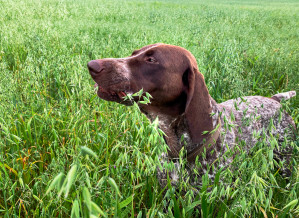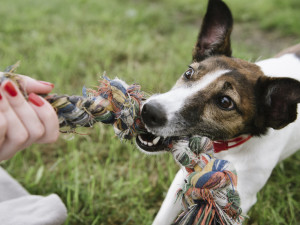Why Does My Dog Eat Rocks?
That is not a treat, pal.
In This Article:
Why Does My Dog Try to Eat Rocks? Causes of Pica In Dogs Related Pica Behaviors Health Risks Associated with Rock Eating Treatment for Dogs Eating Rocks Frequently Asked Questions
Dogs eating rocks, a behavior known as pica, can stem from various underlying causes, including nutritional deficiencies, boredom, anxiety, or certain medical conditions. While occasional curiosity about rocks is normal, persistent rock eating can pose serious health risks to your dog.
Why does my dog try to eat rocks? Causes of pica in dogs
Pica is the behavior of eating non-food substances. Pica can be seen in dogs of all ages and breeds. Dogs with pica will eat anything, and commonly ingested materials include dirt, grass, fabric, and rocks. Figuring out why a dog may actually want to eat a rock can be difficult, but the behavior can be dangerous and a sign of a behavioral or medical issue. Reasons that dogs may eat rocks include:
Nutritional deficiencies or health issues
Some dogs will instinctively crave dirt and rocks when they have underlying deficiencies in essential minerals like iron or zinc. Nutritional deficiencies can develop due to inadequate intake. Dogs who eat raw and homemade diets are often at higher risk of developing nutritional deficiencies when their diets are not properly formulated and prepared.
How much do you spend on your pet per year?
Digestive diseases like exocrine pancreatic insufficiency and inflammatory bowel disease can cause poor absorption of ingested nutrients. Anemia from any cause (blood loss, bone marrow disease, immune-mediated, etc) is a known cause of pica in dogs.
Boredom or curiosity
Dogs like to explore with their mouths, and when they encounter a rock with an interesting scent or texture, they may be tempted to give it a taste. Many dogs chew on objects as a part of play, so they may turn to rocks to satisfy their urge to chew when not provided with appropriate chew toys.
Medications
Steroids like prednisone are used to treat many different health issues in dogs. Side effects of steroids include increased thirst and hunger. This can lead to behavior changes like constantly begging for food or opting to satisfy an insatiable appetite by eating things that aren’t food.
Anxiety or stress
Stress can cause dogs to exhibit various behaviors, including pica and excessive chewing. Some dogs turn to chewing on rocks as a way to cope with anxiety, which can lead to accidental or intentional rock ingestion. Dogs are more likely to engage in these behaviors during thunderstorms, fireworks, environmental changes, or if they have underlying separation anxiety.
Teething
Puppies go through a teething phase from around five weeks to six months of age. Puppies are known to be mouthy and chewing can help soothe a teething puppy’s achy gums. However, puppies don’t always make the best decisions and may seek out rocks or other inappropriate objects to gnaw on, especially if they aren’t provided with appropriate teething toys.
Related pica behaviors
When witnessing the abnormal habits associated with pica disorder, dog parents are often left wondering, “Why does my dog eat dirt, rocks, and wood?” This behavior can extend beyond objects found in the yard. Other pica behaviors include eating:
Feces from themselves or other animals (coprophagy).
Metallic objects like coins, jewelry, or nails (this is especially dangerous if the metal contains zinc).
Fabrics like bedding, clothing, and socks.
Paper products, books, and cardboard.
Plastic and rubber
Health risks associated with rock eating
Dog parents should immediately address the behavior if a dog is eating rocks. Seek veterinary advice to determine if immediate treatment, careful monitoring, or behavior modification is recommended. Rock eating in dogs carries serious health risks, including:
Dental damage
Chewing rocks can lead to cracked or broken teeth in dogs. Dental damage can lead to the need for veterinary tooth repair or removal.
Intestinal obstruction
Stomach acid can’t digest rocks, so a dog that eats a bunch of small rocks or even just one large rock is at risk for developing an intestinal obstruction. Rocks that get stuck in the gastrointestinal tract can cause obstructions that require surgical intervention. Sharp rocks can cause perforations in the intestinal wall, leading to the need for intestinal resection, a more complicated surgery.
Abdominal or esophageal pain
Even if a rock is able to make it all the way through a dog’s gastrointestinal tract, that doesn’t mean that the dog will enjoy the journey. Rocks can cause pain as they move down the esophagus and through the intestines. It can also be painful for a dog to pass rocks in their poop.
Constipation
When thinking about dogs eating rocks, we often imagine large stones, but smaller rocks, fine gravel, or sand (from a litter box or beach) can also be ingested. Once these tiny rocks reach the colon, the body removes water from the material around them, creating hard, gritty stool that is difficult for the dog to pass.
Treatment for dogs eating rocks
Determining if your dog is eating rocks due to a medical or behavioral issue will help guide how to proceed with treatment and avoid rock ingestion in the future. Treatment for pica syndrome in dogs varies, but can include:
Addressing underlying medical issues
Your veterinarian may recommend blood work or other diagnostics to help identify nutritional deficiencies or underlying health conditions that require medication, medical treatments, or a diet change. Dog parents should always ensure to feed a complete and balanced diet that meets AAFCO standards for their dog’s life stage.
Alleviating stress and anxiety
Dogs thrive off consistency, so establish a routine that adds predictability to your dog’s day. If your pup gets separation anxiety, consult with a vet or veterinary behaviorist to help identify your dog’s triggers and methods for desensitization and conditioning. Have a stress-reduction plan in place for anxiety-inducing events like thunderstorms, fireworks, or construction.
Restricting access
Some dogs are just determined to gnaw on rocks just for the hell of it, so dedicated dog parents have to go to great lengths to limit their dog’s access to rocks. Some to consider:
Removing all rocks from the yard and landscaping, if possible.
Leash walks with strict supervision and detours around areas with rocks.
Using a basket muzzle to prevent ingestion.
Redirecting energy
Providing physical activity and mental stimulation can help reduce your dog’s inclination to chew on rocks. Dog parents can provide these outlets for their dog’s energy:
Regular exercise can help tire your dog out and make them less likely to engage in unwanted behaviors.
Toys and food puzzles can help curb boredom.
Age-appropriate chew toys can satisfy the urge to gnaw on something, especially for teething puppies.
Teach your dog the “drop it” command to easily retrieve unsafe objects from their mouths. Reward them with a treat.
FAQs (People also ask):
Can rock eating be a phase that dogs grow out of?
Rock eating can seem temporary, especially for some teething puppies, but it can also be a sign of a medical or behavioral issue. Dog parents should address rock eating immediately. Don’t wait for it to stop as a dog matures.
Why does my dog eat dirt?
Dogs eat dirt for many of the same reasons they eat rocks, including boredom and stress relief. Eating dirt can also be a sign of a health issue like anemia or iron deficiency.












